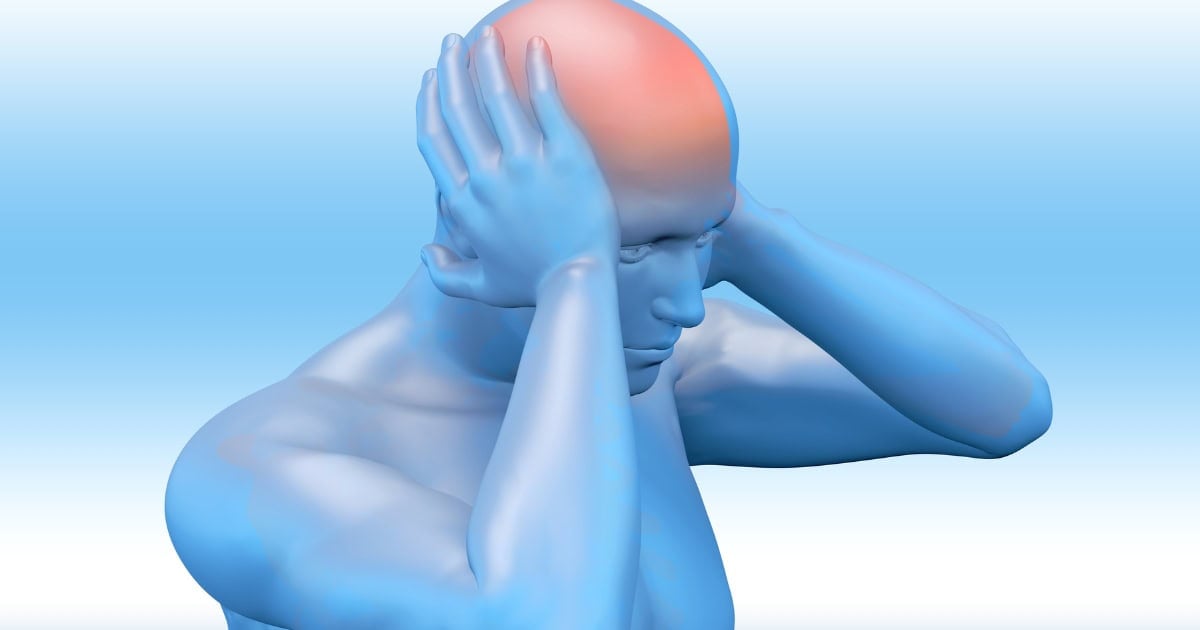Occasional headaches are normal, but frequent headaches may be linked to something more significant, like your blood glucose (sugar) levels if you have type 1, type 2, or prediabetes.
Managing blood sugar fluctuations could help reduce or prevent these headaches.
This article explores how diabetes can trigger headaches and offers tips to manage them effectively.

Key Points:
- Blood sugar fluctuations — both high and low — can trigger headaches in people with diabetes.
- Dehydration, common in diabetes, can trigger headaches and raise blood sugar levels.
- High blood pressure, often associated with diabetes, may cause headaches and other serious health issues.
- Proper management of blood sugar levels, hydration, and blood pressure can reduce the frequency and severity of headaches.
Can diabetes cause headaches?
Yes, diabetes can cause headaches due to blood sugar fluctuations, dehydration, and high blood pressure. Diabetic headaches can vary in location, but many people report feeling pain in the temples or across the forehead during blood sugar fluctuations.
How and why diabetes might be causing your headaches
Diabetes headaches aren’t much of a mystery, as blood sugar fluctuations are a key trigger.
Your brain relies on a constant supply of glucose to function properly. When your blood sugar is outside the ideal range, your brain — and other parts of your body — will notice.
And just like with diabetes, prediabetes can also cause headaches due to fluctuations in blood sugar levels.
Here’s how blood sugar fluctuations may contribute to headaches.
When your blood sugar is low…
When your blood sugar is low, it can cause a ‘sugar headache’ that feels brutal, like your skull is cracking apart.
Your brain needs a constant supply of glucose to function properly, and when that “fuel tank” is empty, symptoms like confusion and lack of coordination are clear signs your brain is struggling.
During low blood sugar episodes, diabetic headaches may be felt in different areas of the head, often concentrating in the temples or forehead.
This headache is your brain’s way of signaling its need for fast-acting carbohydrates to recover.
Learn more in: What Low Blood Sugar Feels Like.
When your blood sugar is high…
When your blood sugar is high, your brain isn’t getting the fuel it needs because insulin is required to help your cells use glucose.
While the symptoms of high blood sugar may not feel as urgent as low blood sugar, your body is still under stress.
Without enough insulin, glucose floods your bloodstream, leading to the production of dangerous ketones and dehydration.
Dehydration is a well-known cause of ‘sugar headaches’ and can worsen high blood sugar by concentrating glucose in the blood. Staying hydrated is just as crucial as taking your medications, but it’s easy to overlook.
See more in: What Does High Blood Sugar Feel Like?
If you have high blood pressure…
Left untreated, high blood pressure can cause severe damage to your heart, arteries, kidneys, and eyes, and increases your risk of stroke and blood clots.
It can also lead to difficulty sleeping and sleep apnea, which can both trigger more headaches.
Read more in: Diabetes and High Blood Pressure: What Is the Relationship?
If your headaches are unrelated to your diabetes…
If your headaches persist or become unmanageable, you may be dealing with migraines, which are much more complex than regular headaches.
Many other health conditions, unrelated to diabetes, can also cause headaches. Don’t hesitate to reach out to your healthcare team if your headaches worsen or if you suspect they might be migraines.
How to treat and reduce the frequency of your headaches
Instead of relying on over-the-counter (OTC) painkillers, there are many ways to manage your headaches.
Painkillers like acetaminophen won’t solve headaches caused by persistent blood sugar or blood pressure issues — you need to address the underlying problem for lasting relief.
Get those high blood sugar levels down
High blood sugars aren’t random — they result from an imbalance of food, activity, medication, stress, and hormones.
If you have type 1 diabetes and are experiencing persistent high blood sugar, it’s time to adjust your insulin doses and how you manage insulin for meals.
Simply put, high blood sugar in type 1 diabetes means you’re not getting enough insulin. While nutritional changes can help, ensuring you have the right insulin dose is the top priority.
Insulin needs change throughout life — don’t hesitate to work with your healthcare team to make adjustments.
For people with prediabetes or type 2 diabetes, starting medication can feel daunting, but it’s important.
Diabetes is progressive, meaning your body’s ability to produce and use insulin declines over time.
Starting diabetes medication is essential, not just for reducing headaches, but also for protecting your eyes, kidneys, and other organs. Don’t let fear or shame stop you from taking the steps needed to lower your blood sugar.
Gradual changes in your diet can make a big difference. Perfection isn’t required — small, consistent adjustments are more sustainable. Remember to leave room for a treat; balance is key.
Physical activity, even just walking for a few minutes after meals, can lower after-meal blood sugars and help reduce insulin resistance. Over time, this can help with weight loss, which will further improve blood sugar levels.
High blood sugars are not random, and there are many medications and lifestyle changes that can help bring them down. Let those headaches be a motivator to take action!
Reduce the frequency of your low blood sugars
If you take insulin or other medications that lower blood sugar, managing low blood sugars will always be a part of life.
To treat lows effectively, use fast-acting carbohydrates that don’t contain much fat or protein, as these slow down glucose absorption, keeping your blood sugar low for longer.
If you’re experiencing frequent lows, it’s a clear sign your medications may need adjusting.
For example, many people with type 2 diabetes are prescribed a set insulin dose without being taught to match their insulin to their carbohydrate intake, which can lead to frequent lows.
Insulin needs change throughout your life — if you lose weight or make changes to your diet, your insulin requirements may decrease, and doses should be adjusted accordingly.
Exercise is another factor that can make managing lows tricky. But frequent hypoglycemia (low blood sugar) during exercise is not inevitable.
By learning how different types of exercise affect your blood sugar, you can prevent these drops.
Finally, if you’re dealing with frequent lows or unpredictable blood sugar swings, talk to your healthcare team or diabetes coach.
Fine-tuning your insulin doses and strategies can make a big difference in preventing recurring lows.
Get your blood pressure down
Lowering your blood pressure won’t just help reduce headaches — it could save your life.
Persistent high blood pressure increases your risk for serious complications, and in some cases, it can spike suddenly, posing an immediate threat.
Here are a few recommendations from the American Diabetes Association (ADA) to help lower your blood pressure:
- Talk to your healthcare team about treatment options.
- Research medications like ACE inhibitors, ARBs, beta-blockers, calcium channel blockers, and diuretics.
- Increase whole grains in your diet and reduce your salt intake using herbs, spices, and low-sodium substitutes.
- Avoid packaged foods with more than 400 milligrams (mg) of sodium per serving.
- Focus on whole, unprocessed foods whenever possible.
- Set a weight-loss goal and incorporate daily walking or other physical activity.
- Limit alcohol and quit smoking if you haven’t already.
Ultimately, lowering your blood pressure comes down to adopting a healthier lifestyle. You don’t need to be perfect — if 80 percent of your choices are healthy and active, you’ll see improvements over time.
Drink more water!
It may sound obvious, but staying hydrated can be harder than it seems, especially with diabetes.
Dehydration can cause both headaches and high blood sugar levels. When you’re dehydrated, glucose becomes more concentrated in the bloodstream, leading to higher blood sugar, which only worsens dehydration-related headaches.
To stay hydrated, aim for about two liters of water (roughly 8 ½ cups) per day. Here are a few tips to help:
- Use a large reusable container to track your intake. Figure out how many servings make up two liters, and aim to hit that goal by the end of the day.
- Start your day with a glass of water before coffee. That quick chug will help get you on track for the day.
- Set phone reminders every few hours or ask yourself mid-morning, “Have I had enough water today?” After a few weeks, drinking water will become a habit.
- If your headaches persist despite staying hydrated, speak with your healthcare team to rule out migraines or other unrelated conditions.
Did you find this article helpful? Click Yes or No below to let us know!





Sunny
Thank you for the information about diabetes and headaches. I have them both (type 1). I’m a pump user but still have high sugar all night. Your advice is really appreciated.
Carrolyn Barloco
Excellent article both as information and practical application! I’ve had Type 1 for 38 years and appreciate your holistic view of dealing with the every day issues. Thanks!